|
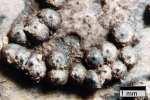
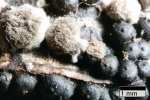

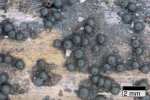
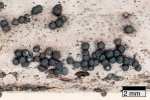
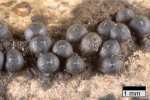
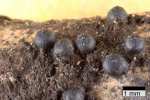
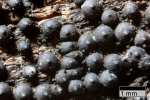
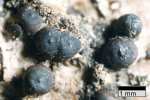
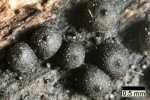
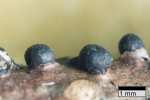
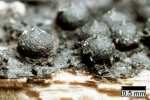
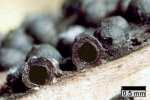
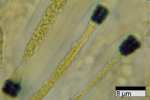
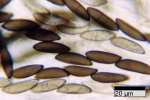
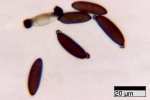
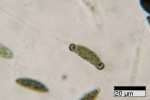
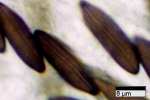

|
Rosellinia brittanica L. E. Petrini, O. Petrini & S. M.
Francis.
Stromata uniperitheciate, scattered to gregarious, rarely
fused together, dark brown to black, carbonaceous, hemispherical with usually flattened
top and broadly attached base, 0.7-1.2 mm diam x0.5-0.9 mm high, mostly 0.8 x
0.7 mm; host surface usually blackened around the stromata; subiculum present
during stromatal maturation, pale brown, of thin-walled hyphae
3-5 µm broad, bearing the felty anamorph at first stages; whitish remnants of subiculum are
present on young stromata, and brown hyphae remain at the base of mature stromata
but are easily overlooked.
Ostioles minutely papillate, conical.
Asci cylindrical, with apical apparatus cylindrical to slightly urn-shaped with a rim
at the , amyloid, (4-) 5.5-6.8 (-7.5) µm high x 3.4-4.8 µm broad.
Ascospores (20-) 22-27 x 7-9.5 µm, ellipsoid-inequilateral,
brown, with ends darker and usually pinched, with a straight to slightly sinuous,
often slightly oblique germ slit spore-length on the less convex side; a slimy
sheath present at both ends as rounded
slimy caps, extending on the flattened side but barely visible.
Anamorph in nature: Geniculosporium-like, present on subiculum
at young stages or on overmature stromata.
Specimens examined: FRANCE: Ariège (09): Alzen,
Montredon, 25 May 1996, JF-96080, on living stem of Buddlea variabilis;
Montseron, Roquebrune, 06 Feb. 1998, JF-98028, on Hedera helix;
Rimont, Las Muros, 11 Apr. 1994, JF-94001, on dead canes of Rubus fructicosus; Rimont,
Las Muros, ruisseau de Peyrau, 28 Apr. 1996, JF-96039, on dying Lonicera
nigra; Rimont, Las Muros, 18 Jun. 1996, JF-96079, on Cornus sanguinea;
Rimont, Las Muros, 08 May 2002, JF-02078, on dying Lonicera nigra;
Rimont, Las Muros, 01 Aug. 2003, JF-03130, on dead stem of Lonicera nigra;
Rimont, Las Muros, 31 Dec. 2003, JF-03237, on dying Lonicera nigra; Rimont,
Sourroque, 15 Sept. 1996, JF-96114, on Lonicera periclymenum. Aude
(11), Montmaur, La Forêt, 23 Feb. 2002, JF-02044, on Populus tremula.
Haute Garonne (31): Escalquens, 13 Nov. 1994, JFM-94130,
on Quercus or Fraxinus;
Escalquens, JFM's place of residence, 15 March 2003, JFM-0314, on bamboo;
Escalquens, JFM's place of residence, 15 March 2003, JFM-A0315 on Arundo
donax;
Fonsegrive, 31 Aug. 1996, JFM-9638, on broad leaved tree;
Fourquevaux, Château Palis, 7 March 1999, JFM-9915, on bamboo;
Martres Tolosane, le Moulin, Camping, 27 Apr. 2002, JF-02065, on dying Lonicera
nigra; Toulouse, CRS park, 11 Dec. 1994, JFM-94161, on Hedera. Gironde (33),
Mongauzy, 23 March 1996, JFM-9630, on broad leaved tree;
Mongauzy, 11 Apr. 2003, JFM-0319, on Camaerops excelsa. Indre et
Loire (37): Le Louroux, spring 2003, leg. P. Leroy, on Epilobium
hirsutum.
Notes:When studying herbarium material named R.
mammaeformis, Petrini et al. (1989) demonstrated that several
different species were mixed under this name. Rosellinia britannica was
erected as a new species primarily based on ascospore and ascal apical apparatus
dimensions which diverge from typical R. mammaeformis. Rosellinia
mammaeformis and R. britannica are superficially similar in their
flat-topped stromata and evanescent subiculum. Rosellinia britannica
differs in having larger ascospores with slimy caps only visible at both ends, and larger ascal apical apparatus.
Rosellinia britannica is widespread in Europe,
known from Denmark, France, Italy, Great Britain and Switzerland (Petrini
et al.,1989), and is widely plurivorous, frequent on Hedera helix
and Fraxinus, but also rcorded on bamboo, palm, herbaceous stems (Epilobium
hirsutum) and various woody substrates (present study). Along with R.
corticium, it is the most frequently encountered species of Rosellinia
in our region.
Rosellinia britannica exhibits wide variations
in morphological and microscopical features, but all usually fall within the
variation range stated by Petrini et al. (1989). Its occurrence on dying
or recently dead stems of Lonicera nigra and Buddlea variabilis
recorded during this study led the authors to thoroughly compare this material
with typical material found on dead wood. Observed variations were falling within
the variation range given by Petrini et al. (1989), except the absence
of slimy caps on ascopore ends recorded in most of collections on dying Lonicera
nigra. This correlation between a supposed pathogenic action and a faint
morphological difference needs to be corroborated by further observations.
|